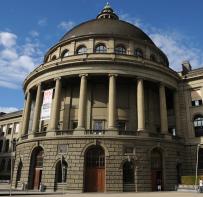 Finally, a blog entry starting with the letter Z, after over three years of writing. This leaves only Q and X unused. I'll get to them eventually. In 1976, I was at Codex Corporation, working on the design of a data communications product called a "statistical multiplexer". My title was "Senior Member, Technical Staff", and I reported to the principal designer of this product, Jim Vandermey, collaborating with him on the design. It was a highly innovative, state-of-the-art product. Note 1 One day, Jim called me into his office, and asked if I would be willing to do him a favor. He had written a paper about the architecture of our product, and had submitted it to the 1976 International Zürich Seminar on Digital Communications. Only after it was accepted had he discovered that due to a prior commitment, he would be unable to attend the conference and deliver the paper. Since I was one of the designers of the product, he had put my name on the paper as a co-author. Would I be willing to travel to Zürich, attend the conference, and deliver the paper? I readily accepted. Although the majority of technical conferences these days seem to be conducted in English, the Zürich seminar had three official languages in which papers could be delivered: English, German, and French. As any reader of my blog knows, I love foreign language study, and at the time I spoke all three of these languages (my German has since deteriorated rather badly). Do Jim a favor? Hardly. It seemed to me that this would be a wonderful trip. Note 2
But it turned out that Fasnacht in most of Switzerland, curiously, begins on the Monday after Ash Wednesday (I was told it was a protestant version of Mardi Gras). A parade was to be held, as well as a celebratory costume ball open to the public. Attendance at the Fasnacht events worked the way the New Year's celebration First Night® works in Boston and other cities. People bought a pin-on badge to wear to indicate that they had paid for entry to the various public events. This was explained to me in German by a couple of people who accosted me on the street. I was able to understand what they were selling, and I bought and wore one of the badges. When I later watched the parade, I found that quite a few of the fair-minded Swiss were openly criticizing people watching the parade who were not wearing a badge. They felt that people who hadn't contributed to the cost of the event shouldn't be watching the parade. Fortunately, I was wearing my badge. What I wasn't wearing, actually, was a warm enough coat. The warmest coat I had brought with me proved to be not quite heavy enough for the March chill of Zürich. I also attended the costume ball. This took a bit of creativity, since I hadn't brought any sort of costume with me. But I did have some polka dot pajamas, and I purchased some brightly colored face paints, with which I converted myself into a clown. It was a lot of fun. You can click the next link to see many photographs from past events. Oddly, this record starts in 1977, the year after I visited. The conference itself was also fascinating. I absolutely reveled in being able to speak all three languages in use at the conference. Of course, I could understand the papers presented in English, and I found my French was sufficient to understand the French presentations. My German was good enough for everyday communication in Zürich, where German is the predominant language. But it was not good enough to understand technical presentations. I missed most of the words in those, although I could sometimes follow along with the written papers in the printed proceedings. My own presentation went well (I was, of course, presented to the audience as "Doctor Krakauer"). I decided that people who were interested could read the paper in the proceedings, so I departed from the written text quite a bit in my oral presentation, giving additional information that was not in the printed paper. This might not have been a great idea, given that some people following my presentation might not have spoken English all that well. Most of the presenters essentially read their written papers from the lectern. Nevertheless, given the number of questions I received after the presentation, the paper was well received. I got a lot of questions from a particular group of engineers from a French-speaking area of Switzerland, who were delighted to find that I could explain things to them in French. I attended all of the sessions of the conference, and found most of the papers to be quite interesting.
I particularly recall a wonderful lunch in which I had a plate of pfifferlinge (picture to the right), more commonly known by their French name, chanterelles. Like many fresh mushrooms, pfifferlinge are only served in season, but I had the luck to arrive during the right time of year. These lunches, like the conference itself, were fascinating multilingual events. My friend and former MIT roommate Martin Schrage had given me an introduction to his Swiss friend Heinrich Heer, who lives near Zürich. He kindly treated me to dinner one evening after a day at the conference. I was fascinated watching his manner of speaking change to fit the occasion. He spoke to me primarily in English, of course. But he also switched at will between a formally correct German (so-called High German, or Hochdeutsch) and the local Swiss German (called Schweizerdeutsch in Hochdeutsch, but more like Schwyzerdütsch locally). Heini could, at will, sound like either the sophisticated international businessman he was, or like a hick from the sticks.
But It didn't occur to me to try to contact anyone who had been involved in the computer chess game between MIT and the ETH in which I had earlier assisted by providing an amateur radio connection (see my blog entry Computer chess via ham radio). Contact with the people at the ETH had been primarily made by the author of the chess program, Richard Greenblatt, and I hadn't been very much involved in dealing with the people at the ETH. When I returned to Codex after the conference, I circulated the conference proceedings, and told people to contact me if they had any questions about any of the papers, as I had attended all the presentations. Someone asked me why I had done that. He said that apart from presenting my own paper, I should have skipped the rest of the conference, and simply taken advantage of a company paid vacation in Zürich. I had figured that since the company was sending me to the entire conference, at considerable expense, I was not just there to present my own paper. On the other hand, many of the papers were not particularly of interest to Codex, as they concentrated on aspects of telephony. Note 3 So I really could have skipped a few of them. Then again, I enjoyed the papers and the trilingual atmosphere, and I had plenty of time outside the conference to see Zürich, and participate in the Fasnacht activities. All in all, this was one of my best business trips. I brought back a child's dress of Swiss design, pale yellow, decorated with what my wife calls "eyelet lace", for my then six-month old daughter Elissa. This dress has just been brought out of storage, to be worn by Elissa's 10-week old daughter Darwin when she gets old enough.
  Note 1: The statistical multiplexer was ultimately released as the Codex 6030. For you techies: the design was based on a tightly-coupled multiple-microprocessor architecture, with a high-speed bit-slice master microcontroller. I did the detailed hardware design, wrote firmware for the microcontroller, debugged the product, and released it to production. The product included multiple 6800 microprocessors. It was rather more difficult to develop than it would be now, because at the time, logic analyzers and similar digital development tools were not available. You can learn more about this product in A History of Computer Communications: 1968 -1988, by James L. Pelkey. In particular, some notes on the 6030 statistical multiplexer and be found on this page. [return to text] Note 2: The paper was "The Architecture of a Multiple Microprocessor Communications Processor", J. E. Vandermey and L. J. Krakauer, Proceedings of the 1976 International Zürich Seminar on Digital Communications, pg. C6 (March 1976) (IEEE Catalogue # 76CH1054-6ZURICH). Although I was involved in the design of the product described in the paper, Jim was very much its principal architect. [return to text] Note 3:
"Telephony", which is pronounced with the stress on the second "e" (te-LEH-fe-nee), is the science of translating sound into electrical signals, transmitting them, and then converting them back to sound. Many of the papers at the conference related to digital communications as specifically applied to telephone systems, not a major interest of Codex, which was primarily a modem manufacturer. [return to text]
 |
 The picture to the left shows the delightful city of Zürich, Switzerland, with the Alps glimmering in the distance. Shortly after arriving, I discovered that the city was about to celebrate Fasnacht, the Swiss version of Mardi Gras, the beginning of Lent. This surprised me, because Mardi Gras had been celebrated in most of the world just before I left for my trip.
The picture to the left shows the delightful city of Zürich, Switzerland, with the Alps glimmering in the distance. Shortly after arriving, I discovered that the city was about to celebrate Fasnacht, the Swiss version of Mardi Gras, the beginning of Lent. This surprised me, because Mardi Gras had been celebrated in most of the world just before I left for my trip.
 As noted above, my use of German was primarily to get around Zürich when I was not involved in the conference sessions. I often went to lunch with people I had met, which included some employees of various European offices of Codex.
As noted above, my use of German was primarily to get around Zürich when I was not involved in the conference sessions. I often went to lunch with people I had met, which included some employees of various European offices of Codex.
 The conference was on the campus of the Swiss Federal Institute of Technology in Zürich, called in German the Eidgenössische Technische Hochschule Zürich (ETH, photo to the left).
The conference was on the campus of the Swiss Federal Institute of Technology in Zürich, called in German the Eidgenössische Technische Hochschule Zürich (ETH, photo to the left).